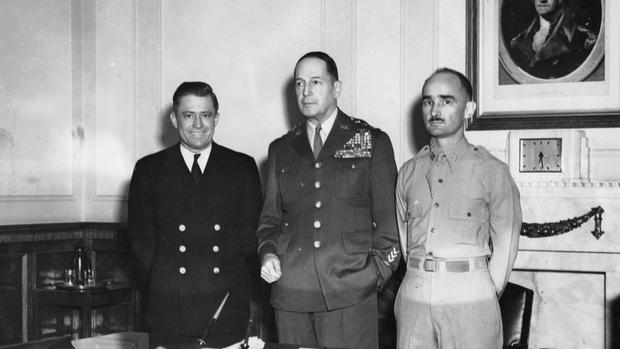December 3, 2016, 12:27 PM
Legacy of General Douglas MacArthur lives on at his war office
Wednesday marks 75 years since Japan’s devastating attack on the U.S. naval base at Pearl Harbor, Hawaii. The surprise attack immediately drew the U.S. into World War II, and within days, American troops landed in Australia to begin defending the Pacific.
On the eighth floor of what was once the sturdiest building in downtown Brisbane, echoes of history reverberate off the wood-paneled walls.
For more than half of World War II, U.S. Gen. Douglas MacArthur ran the Allied fight in the Southwest Pacific from a suite in Australia’s third-largest city. It’s now part of the MacArthur Museum, reports CBS News correspondent Mark Albert.
“We’re in the actual office of Gen. Douglas MacArthur,” said John Wright, the museum’s executive officer.

General Douglas MacArthur (center)
“This is where he worked?” Albert asked.
“This is where he worked,” Wright said.
“Do you feel when you walk in here that you’re following the footsteps of General MacArthur?” Albert asked.
“There is an aura of history about it,” Wright said.
Just 15 days after Pearl Harbor, stunned by the sudden arrival of war, U.S. troops began arriving in Brisbane – the first of an eventual one million who would pass through Australia.
In time for the 75th anniversary, the museum has finished restoring the general’s office. The bronze door handles have returned and the timber work revived.
“Why was it important to restore his office to the way that it was?” Albert asked.

CBS News
“This is a museum which is in a position to actually show the enormous impact the decisions made in that office had on Australia and on the conduct of the war,” Wright said.
“Why was Australia vulnerable?” Albert asked.
“Well, essentially what was happening was the Japanese were advancing down through the Philippines, simultaneously moving from French Indochina down through the Malay states, into what was then the Dutch East Indies… looking to isolate Australia,” Wright said.
But when MacArthur arrived in Australia in the spring of 1942, he did not land as a conquering hero. He was forced to flee the Philippines with his family, issuing his famous promise: “I shall return.” And he did, but not for two and a half years.
“Was he sort of licking his wounds?” Albert asked Walter Borneman, who wrote the just-released book “MacArthur at War.”
“He was definitely licking his wounds,” Borneman said.
“How does a general on a losing streak go to Australia and by the end of World War II become someone extremely popular throughout the country?” Albert asked.
“MacArthur fills the need in the American psyche for a hero,” Borenman said. “To MacArthur’s credit, by the time 1944 comes along, he’s doing a lot of island hopping, he’s really bought into the whole concept of air power. He’s doing miraculous amphibious landings all over. So he does evolve as a military commander.”
Three-quarters of a century later, 1,250 U.S. Marines are deployed in the northern Australia city of Darwin for training – a sign, Australian army Capt. Adele Catts told CBS News, of the enduring partnership.
“I think that the collaboration that occurred with U.S. troops in World War II under General MacArthur certainly has laid the groundwork for the U.S. and Australian joint operations that exist now,” Catts said.
Today, MacArthur’s legacy lives on there in other ways. His old headquarters building has been named after him, and there’s an Apple store on the ground floor, right next to the MacArthur Central mall.
In Greater Brisbane, there are streets, roads, drives, circles and bus stops named after the general, who still touches 84-year-old resident Del Hicks. Hicks played with Arthur MacArthur, the general’s son, while the family lived in Brisbane.
Jean MacArthur, the general’s wife, even sent Hicks a letter after the family left.
“Dear Del, Arthur wants me to send you this little note to tell you how much he has missed you,” she wrote in a letter that Hicks has kept for 71 years.
“I think what nice people they were. Mrs. MacArthur was a charming woman. And I always remember the general had lovely, soft hands because one day he just took Arthur’s hand and my hand and we just went down the hall singing this little song,” Hicks said.
Ron Rees said MacArthur gave him a lieutenant’s pin when he was just 6 years old and a letter after a chance reunion in New York over tea 20 years later.
Rees is now a volunteer at the MacArthur Museum.
“It’s some small manner of replaying what the United States and our allies, the Australians, did for me,” Rees said.
Despite that adoration and his status as one of the most famous generals in U.S. history, MacArthur apparently never let go of certain insecurities, as Wright told Albert in his office – like how he placed a picture of President George Washington in his office.
“Whereas you normally expect the U.S. president of the day, Franklin Roosevelt, to be up there, he made the comment that he wasn’t having any Democrat looking down on him,” Wright said.
“He was a Republican,” Albert said.
“And he was a Republican with probably ambitions to the 1944 presidential nomination,” Wright said.
MacArthur didn’t end up campaigning for president. Instead on Sept. 2, 1945, he accepted Japan’s surrender on the deck of the USS Missouri. That day, he famously told the American people in a radio address: “We must go forward to preserve in peace what we won in war.”
© 2016 CBS Interactive Inc. All Rights Reserved.
